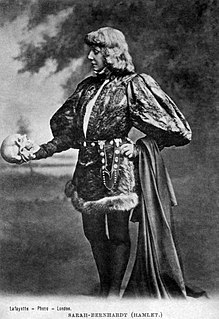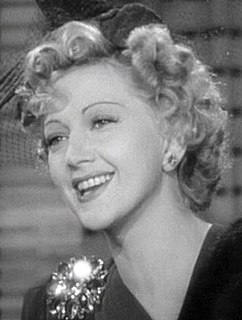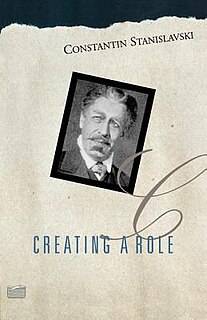Related Research Articles

Acting is an activity in which a story is told by means of its enactment by an actor or actress who adopts a character—in theatre, television, film, radio, or any other medium that makes use of the mimetic mode.

Improvisational theatre, often called improvisation or improv, is the form of theatre, often comedy, in which most or all of what is performed is unplanned or unscripted: created spontaneously by the performers. In its purest form, the dialogue, action, story, and characters are created collaboratively by the players as the improvisation unfolds in present time, without use of an already prepared, written script.

Konstantin Sergeyevich Stanislavski was a seminal Soviet and Russian theatre practitioner. He was widely recognized as an outstanding character actor and the many productions that he directed garnered him a reputation as one of the leading theatre directors of his generation. His principal fame and influence, however, rests on his 'system' of actor training, preparation, and rehearsal technique.

The Wicker Man is a 1973 British folk horror film directed by Robin Hardy and starring Edward Woodward, Britt Ekland, Diane Cilento, Ingrid Pitt, and Christopher Lee. The screenplay by Anthony Shaffer, inspired by David Pinner's 1967 novel Ritual, centres on the visit of Police Sergeant Neil Howie to the isolated island of Summerisle in search of a missing girl. Howie, a devout Christian, is appalled to find that the inhabitants of the island have abandoned Christianity and now practice a form of Celtic paganism. Paul Giovanni composed the film score.

Method acting, known informally as the Method, is a range of training and rehearsal techniques, as formulated by a number of different theatre practitioners, that seeks to encourage sincere and expressive performances through identifying with, understanding, and experiencing a character's inner motivation and emotions. These techniques are built on Stanislavski's system, developed by the Russian actor and director Konstantin Stanislavski and captured in his books An Actor Prepares, Building a Character, and Creating a Role.

Appalachia is a cultural region in the Eastern United States that stretches from the Southern Tier of New York State to northern Alabama and Georgia. While the Appalachian Mountains stretch from Belle Isle in Canada to Cheaha Mountain in Alabama, the cultural region of Appalachia typically refers only to the central and southern portions of the range, from the Blue Ridge Mountains of Virginia southwest to the Great Smoky Mountains. As of the 2010 United States Census, the region was home to approximately 25 million people.

Stanislavski's system is a systematic approach to training actors that the Russian theatre practitioner Konstantin Stanislavski developed in the first half of the twentieth century. His system cultivates what he calls the "art of experiencing". It mobilises the actor's conscious thought and will in order to activate other, less-controllable psychological processes—such as emotional experience and subconscious behaviour—sympathetically and indirectly. In rehearsal, the actor searches for inner motives to justify action and the definition of what the character seeks to achieve at any given moment.

Lee Strasberg was a Polish-born American actor, director, and theatre practitioner. He co-founded, with directors Harold Clurman and Cheryl Crawford, the Group Theatre in 1931, which was hailed as "America's first true theatrical collective". In 1951, he became director of the nonprofit Actors Studio in New York City, considered "the nation's most prestigious acting school," and, in 1966, was involved in the creation of Actors Studio West in Los Angeles.

Stella Adler was an American actress and acting teacher. She founded the Stella Adler Studio of Acting in New York City in 1949. Later in life she taught part time in Los Angeles, with the assistance of her protégée, actress Joanne Linville, who continued to teach Adler's technique. Her grandson Tom Oppenheim now runs the school in New York City, which has produced alumni such as Marlon Brando, Robert De Niro, Harvey Keitel, Elaine Stritch, Kate Mulgrew, Kipp Hamilton, Jenny Lumet, and Jeff Celentano.

In acting, units of action, otherwise known as bits or beats, are sections that a play's action can be divided into for the purposes of dramatic exploration in rehearsal.
Ann Pancake is an American fiction writer and essayist. She has published short stories and essays describing the people and atmosphere of Appalachia, often from the first-person perspective of those living there. While fictional, her short stories contribute to an understanding of poverty in the 20th century, and well as the historical roots of American and rural poverty. Much of Pancake's writing also focuses on the destruction caused by natural resource extraction, particularly in Appalachia, and the lives of the people affected.

The "art of representation" is a critical term used by the seminal Russian theatre practitioner Konstantin Stanislavski to describe a method of acting. It comes from his acting manual An Actor Prepares (1936). Stanislavski defines his own approach to acting as "experiencing the role" and contrasts it with the "art of representation". It is on the basis of this formulation that the American Method acting teacher Uta Hagen defines her recommended Stanislavskian approach as 'presentational' acting, as opposed to 'representational' acting. This use, however, directly contradicts mainstream critical use of these terms. Despite the distinction, Stanislavskian theatre, in which actors 'experience' their roles, remains 'representational' in the broader critical sense.

The Moscow Art Theatre production of Hamlet in 1911–12, on which two of the 20th century's most influential theatre practitioners—Konstantin Stanislavski and Edward Gordon Craig—collaborated, is particularly important in the history of performances of Hamlet and of 20th-century theatre in general.
The New Actors Workshop was a two-year acting conservatory in New York City founded by Master Teachers Mike Nichols, George Morrison and Paul Sills in 1988. The school offered a unique, dual-track curriculum combining Stanislavski-based technique with Viola Spolin Theater Games. The workshop stopped accepting students in 2010.

An actor is a person who portrays a character in a performance. The actor performs "in the flesh" in the traditional medium of the theatre or in modern media such as film, radio, and television. The analogous Greek term is ὑποκριτής (hupokritḗs), literally "one who answers". The actor's interpretation of a role—the art of acting—pertains to the role played, whether based on a real person or fictional character. This can also be considered an "actor's role," which was called this due to scrolls being used in the theaters. Interpretation occurs even when the actor is "playing themselves", as in some forms of experimental performance art.
Classical acting is a type of acting that is based on the theories and systems of select classical actors including Konstantin Stanislavski and Michel Saint-Denis, including the expression of the body, voice, imagination, personalizing, improvisation, external stimuli, and script analysis.
Maryat Lee was an American playwright and theatre director who made important contributions to post-World War II avant-garde theatre, pioneering street theatre in Harlem and later founding the Eco Theater, which developed drama productions out of oral histories in Appalachia.

Creating a Role is theatre actor/director Constantin Stanislavski's third and final book on his method for learning the art of acting. It was first published in Russian in 1957; Theatre Art Books published an English-language edition, translated by Elizabeth Reynolds Hapgood, in 1961.
The city of Baltimore, Maryland includes a significant Appalachian population. The Appalachian community has historically been centered in the neighborhoods of Hampden, Pigtown, Remington, Woodberry, Lower Charles Village, Highlandtown, and Druid Hill Park, as well as the Baltimore inner suburbs of Dundalk, Essex, and Middle River. The culture of Baltimore has been profoundly influenced by Appalachian culture, dialect, folk traditions, and music. People of Appalachian heritage may be of any race or religion. Most Appalachian people in Baltimore are white or African-American, though some are Native American or from other ethnic backgrounds. White Appalachian people in Baltimore are typically descendants of early English, Irish, Scottish, Scotch-Irish, and Welsh settlers. A migration of White Southerners from Appalachia occurred from the 1920s to the 1960s, alongside a large-scale migration of African-Americans from the Deep South and migration of Native Americans from the Southeast such as the Lumbee and the Cherokee. These out-migrations caused the heritage of Baltimore to be deeply influenced by Appalachian and Southern cultures.